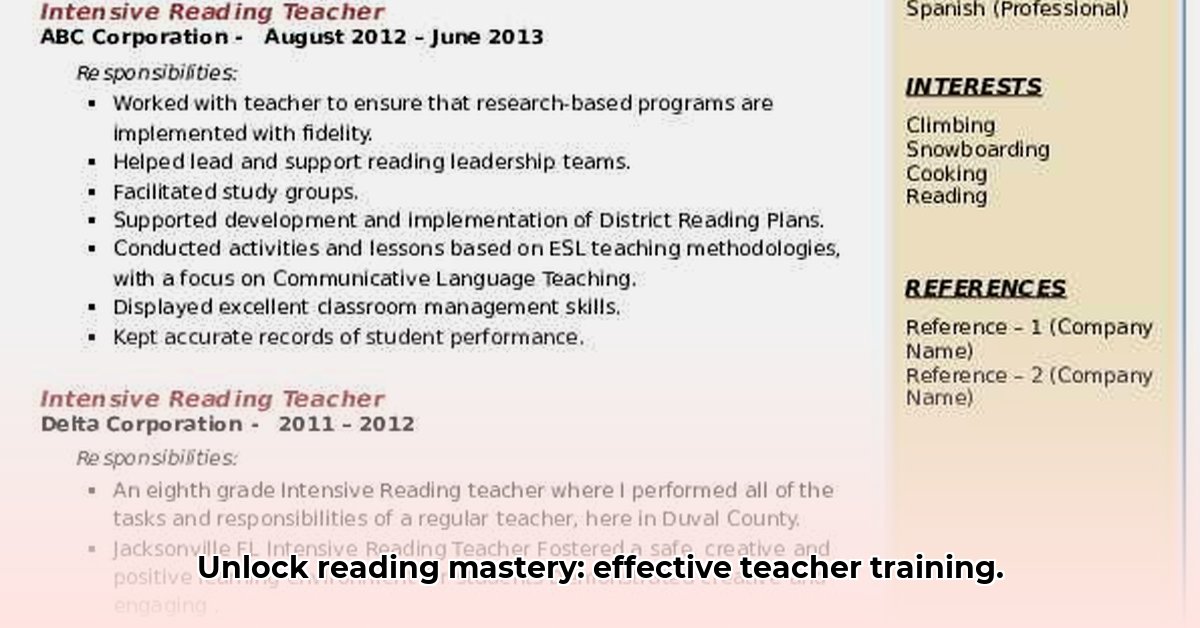
Foundations of Reading Teacher Training: A Comparative Review of Two Leading Programs
Choosing the right professional development program for reading instruction is crucial for educators. This article compares two prominent programs – Keys to Beginning Reading (KBR) and Teaching Strategies' Science of Reading Certification – to help you make an informed decision. We will analyze program structure, content focus, delivery methods, cost, and potential risks, offering actionable intelligence for educators, administrators, and literacy coaches. A key consideration is the alignment of each program with the science of reading, a critical aspect of effective literacy instruction. For more resources on foundational reading, see this helpful guide.
Program Structures and Content Focus: Tailoring Training to Specific Needs
KBR employs a modular, flexible approach, offering a suite of courses focusing on specific reading skills (phonics, fluency, comprehension). Teachers can select modules based on individual needs, choosing between live, online, or blended learning formats. This adaptability is beneficial for busy teachers needing targeted professional development. In contrast, Teaching Strategies offers a more intensive, two-year apprenticeship model. This immersive program provides a comprehensive curriculum, mentorship, coaching, and a collaborative learning community. This structured approach fosters a deep understanding of reading development's interconnected components.
How do these different structures impact teacher learning and implementation? This is a crucial question to consider when matching teacher needs to program design.
Dr. Emily Carter, Professor of Literacy Education at the University of California, Berkeley, notes: "The flexible nature of KBR allows teachers to address specific skill gaps, but Teaching Strategies' immersive model facilitates a more holistic understanding of literacy development and provides continuous support."
Delivery and Time Commitment: Balancing Flexibility with Immersive Learning
KBR's flexibility is a key advantage, allowing teachers to integrate professional development into their existing schedules. The modular design permits adaptation to individual needs and time constraints. Teaching Strategies' two-year commitment requires a significant time investment. However, this intense immersion fosters a deeper understanding of complex literacy concepts and provides consistent support through ongoing coaching and peer collaboration.
What level of time commitment best aligns with your professional goals and personal circumstances? Consider this question carefully when weighing these options against your current workload.
Cost and Value: Short-Term vs. Long-Term Returns
KBR's modularity results in a lower overall cost, allowing teachers to select only the modules necessary. The pay-as-you-go approach offers greater budget flexibility. Teaching Strategies' program represents a larger upfront investment, but offers a more holistic return on investment through enhanced professional growth and skills development over a more extended period. The long-term impact on student learning is a vital consideration.
What is the long-term return on investment for each program? Consider both direct and indirect costs to derive the best value for your professional learning budget.
Actionable Intelligence and Risk Assessment: A Structured Decision-Making Process
Choosing a reading teacher training program requires a systematic approach:
- Define your needs: What specific skills require enhancement? Are you seeking comprehensive training or targeted professional development?
- Assess time commitment: Evaluate how much time you can dedicate to professional development. Can you commit to a two-year program, or do you require more flexible options?
- Evaluate alignment with goals: Does the program directly address your professional development goals? Does it align with your district's literacy initiatives?
- Consider funding: Explore funding options, including grants and professional development budgets.
- Seek feedback: Review teacher testimonials and program reviews to gain insights from other educators' experiences.
Regulatory Implications and Program Accreditation
It is crucial to understand any implications for your licensure or certification. Confirm if either program offers pathways to specific professional certifications or endorsements recognized by your state's education board. KBR offers a potential pathway towards International Dyslexia Association (IDA) certification. Teaching Strategies provides its in-house certificate upon program completion. However, it's vital to check with your state's education department to ensure compliance with all requirements.
Comparative Analysis: A Quick Glance
| Feature | Keys to Beginning Reading (KBR) | Teaching Strategies Science of Reading Certification |
|---|---|---|
| Structure | Modular, flexible | Comprehensive, two-year program |
| Delivery | Live, online, blended | Primarily structured, consistent |
| Focus | Targeted skills | Holistic language and literacy development |
| Time Commitment | Variable, shorter duration | Significant, two-year commitment |
| Community Support | Limited | Strong professional learning community |
| Cost | Lower, pay-as-you-go | Higher, one-time investment |
| Certification | Potential IDA certification pathway | Teaching Strategies in-house certificate |
Conclusion: Making the Best Choice for Your Professional Growth
Both KBR and Teaching Strategies offer valuable training in foundational reading instruction. The optimal choice depends on individual needs, learning styles, available resources, and long-term professional goals. Carefully consider the factors outlined above to ensure the program aligns with your specific context and objectives. Remember to verify alignment with your district's literacy initiatives and state regulations before making a final decision.